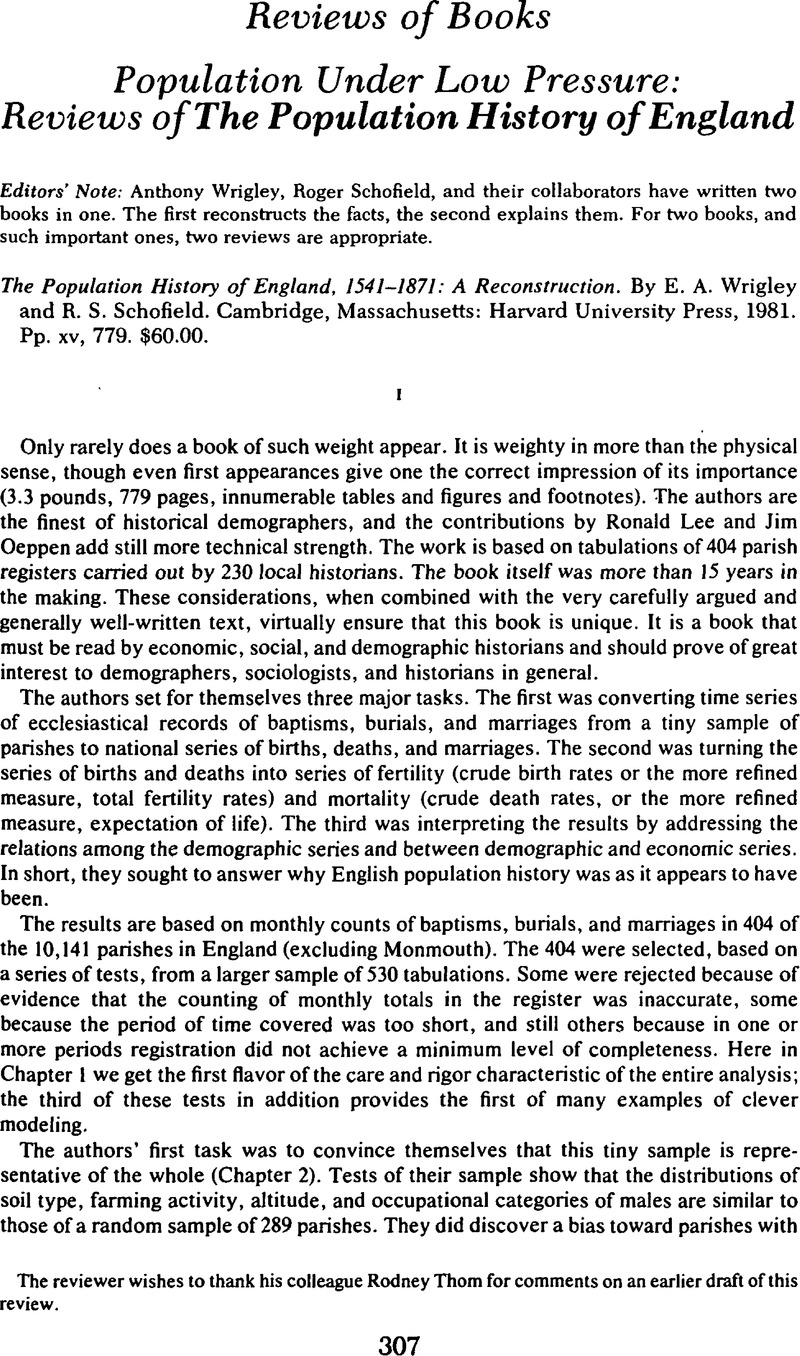No CrossRef data available.
Article contents
Population Under Low Pressure: Reviews of the Population History of England - The population History of England, 1541–1871: A Reconstruction. By E. A. Wrigley and R. S. Schofield. Cambridge, Massachusetts: Harvard University Press, 1981. Pp. xv, 779. $60.00.
Review products
Published online by Cambridge University Press: 03 March 2009
Abstract

- Type
- Reviews of Books
- Information
- Copyright
- Copyright © The Economic History Association 1983
References
For a sampling of the best of recent French work see Jacques Dupaquier, “La population du Bassin Parisien a l'dpoque de Louis XIV” (Lille, 1978)Poussou, Jean-Pierre, “L'immigration bordelaise, 1737–91” (Ph.D. diss., Paris, 1979),Google Scholar
reviewed by Bardet, Jean-Pierre in Annales de Démographie Historique (1979), 445–55.Google Scholar
2 A case in point: in their back projection they use some evidence on Swedish emigrants as a proxy for the age-structure of English emigration (pp. 201, 278). This is unnecessary: Erickson, Charlotte (“Emigration from the British Isles to the U.S.A. in 1831,” Population Studies, 35 [1981], 175–97), has shown how a good age-profile of English emigration may be constructed. The mean age of emigrants in Erickson's sample lies halfway between the Swedish and an alternative schedule used by Wrigley and Schofield in their simulation.CrossRefGoogle ScholarPubMed
3 Dupâquier, Jacques, “Eacute;tude compartive des données concernant la fécondité dans 25 monographies concernant le bassin parisien à la fin du XVII siècle et au début du XVIIIe Siècle,” quoted in Flinn, Michael, The European Demographic System (London, 1981), p. 155.Google Scholar
4 Wrigley, E. A., “Family Limitation in pre-industrial England,” Economic History Review, 2nd ser., 19 (1966), 82–109.CrossRefGoogle ScholarPubMed
Colyton earns 16 references in the index, as in Wrigley's, deservedly popular Population in History (London, 1969),Google Scholar
and heavily infulences the discussion throughout. The representativeness of the parishes chosen has already been seriously questioned by Flinn, Michael in his review of the book in Economic History Review, 2nd ser., 35 (1982), 452–53.Google Scholar
5 The truly massive proportion of never-marrieds is difficult to square with the apparently improving economic climate of the time. Perphaps insufficient account was taken of clandestine marriages. On the scale of the latter see Brown, Roger Lee, “The Rise and Fall of the Fleet Marriages,” in Outhwaite, Richard B., ed., Marriage and Society: Studies in the Social History of Marriage (London, 1981), especially pp, 118–20.Google Scholar
6 Dupâquier, Jacques, “Sans marriages ni sépultures, la réconstitution des familles est-elle possible?émographie Historique (1980), pp. 53–65; Marcel Lachiver, “La réconstitution des familles aux XVIe-XVIIe siècles; (vers 1550–1670),” Annales de Démographie Historique (1980), 97–103.Google Scholar
7 On this point see, for example, Donald N. McCloskey, review of Ramsey, Peter H., ed., Price Revolution in Sixteenth-century England in journal of Political Economy, 80 (1972), 1, 332–35.Google Scholar
8 see Ramsey, Peter, Tudor Economic Problems (London, 1963), pp. 115–16, 137–38;Google Scholar
Woodward, Donald, “Wage Rates and Living Standards in Pre-Industrial England,” Past and Present, no. 91 (1981), 28–46.CrossRefGoogle Scholar
9 During the sixteenth century the money wage series used by Wrigley and Schofield doubled (p. 640). Suppose rents rose sixfold and agriculture prices quadrupled over the same period: these are generous and conservative guesses, respectively. Letting asterisks signify rates of change and defining productivity change as a*= –p* + sLw* + sRr*, and setting the share of labor, sL =1 – sR = 0.7, produces:
which is negative. For rent and agriculture price data, see Kerridge, Eric, “The Movement of Rent 1540–1640,” Economic History Review, 2nd ser., 6 (1953),Google Scholar and Bowden, Peter, “Agriculture Prices, Farm Prices, and Rents,” in Thirsk, Joan, ed., The Agrarian History of England and Wales, 1500–1640 (Cambridge, 1967), vol. 4, pp. 593–695, 814–70. On agriculture change see, for example Joan Thirsk, “Agriculture Techniques,” chap. 3Google Scholar in Thirsk, , Agrarian History, especially pp. 197–99.Google Scholar
10 Flinn, Michael, European Demographic system, p. 100.Google Scholar
11 Connell, Kenneth H., “Some Unsettled Problems in English and Irish Population History, 1750–1845,” Irish Historical Studies, 7, no. 28 (1951), 225–34.CrossRefGoogle Scholar See also the editor's Introduction to Drake, Michael, ed., Population in Industrialization (London, 1969), especially pp. 3–8.Google Scholar


